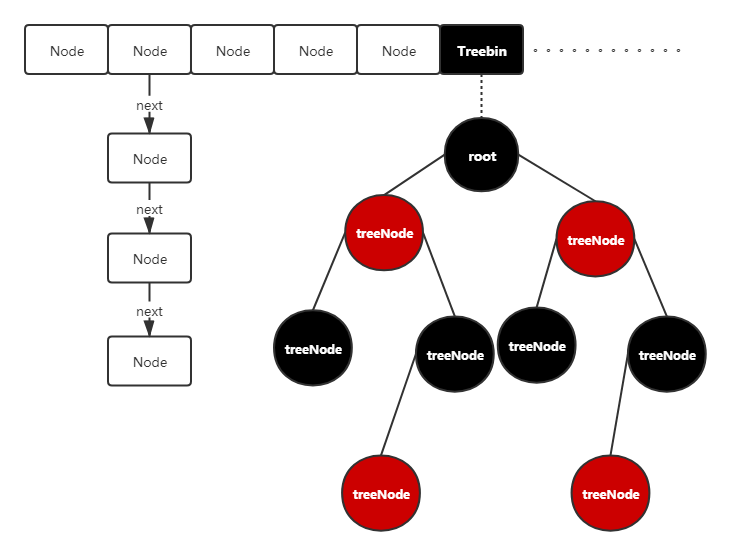数据结构(和ConcurrentHashMap类似)
-
存储数据的基础结构时Node的数组;
-
节点中保存的是当前节点的hash,主键Key,对应值value,链表的next;
transient Node<K,V>[] table;
static class Node<K,V> implements Map.Entry<K,V> {
final int hash;
final K key;
V value;
Node<K,V> next;
}

基础操作
put方法
- 方法和concurrentHashMap类似,其中涉及到红黑树的部分,可以查看另一篇红黑树的详细代码执行过程
/**
* 1.如果没初始化先进行初始化;
* 2.hash对应的位置没有数据,则新增节点
* 3.判断hash,key是否相同,相同则赋值临时值。否则,判断是树状结构则从红黑树中更新值,并返回替换的节点或者返回null;
* 4.判断如果是链表则遍历链表,如果在链表中则返回替换的节点
* 5.完成上面这些后,节点计数+1,判断是否要进行重新调整数组大小
*/
final V putVal(int hash, K key, V value, boolean onlyIfAbsent,
boolean evict) {
Node<K,V>[] tab; Node<K,V> p; int n, i;
if ((tab = table) == null || (n = tab.length) == 0)//如果没有初始化,则进行初始胡
n = (tab = resize()).length;
if ((p = tab[i = (n - 1) & hash]) == null)//hash对应的数组位置为null,则新增Node节点
tab[i] = newNode(hash, key, value, null);
else {
Node<K,V> e; K k;
if (p.hash == hash &&
((k = p.key) == key || (key != null && key.equals(k))))//如果key相等
e = p;//将当前节点赋值临时节点e
else if (p instanceof TreeNode)//如果p节点是红黑树。那么在红黑树中插入节点
e = ((TreeNode<K,V>)p).putTreeVal(this, tab, hash, key, value);
else {
/**
* 遍历链表,查找节点,会出现以下几种情况。
* 1.逐个遍历,判断节点key是否和新插入数据hash,key相等
* 2.如果没有,则新增节点,并判断是否要生成红黑树;
* 生成红黑树的条件:数组最小长度要为64,并且链表个数超过8个时
*/
for (int binCount = 0; ; ++binCount) {
if ((e = p.next) == null) {
p.next = newNode(hash, key, value, null);
if (binCount >= TREEIFY_THRESHOLD - 1) // -1 for 1st
treeifyBin(tab, hash);
break;
}
if (e.hash == hash &&
((k = e.key) == key || (key != null && key.equals(k))))
break;
p = e;//赋值下一个节点查看
}
}
if (e != null) { //如果能查找到节点,则将旧值换新值
V oldValue = e.value;
if (!onlyIfAbsent || oldValue == null)
e.value = value;
afterNodeAccess(e);
return oldValue;
}
}
++modCount;//数量+1
// 判断是否需要重新设置大小
if (++size > threshold)
resize();
afterNodeInsertion(evict);//钩子方法,用于子类实现
return null;
}
/**
* 1.确定新的数组大小
* 2.进行数据节点重排
*/
final Node<K,V>[] resize() {
Node<K,V>[] oldTab = table;
int oldCap = (oldTab == null) ? 0 : oldTab.length;//原始数组长度
int oldThr = threshold;
int newCap, newThr = 0;
/**
* 1.原始长度大于0,当大于等于最大容量,返回现有数组;
* 2.新长度的大小为旧长度两倍且小于最大容量,并且旧长度大于最小初始长度时,新长度为为旧长度的2倍
*/
if (oldCap > 0) {
if (oldCap >= MAXIMUM_CAPACITY) {
threshold = Integer.MAX_VALUE;
return oldTab;
}
else if ((newCap = oldCap << 1) < MAXIMUM_CAPACITY &&
oldCap >= DEFAULT_INITIAL_CAPACITY)
newThr = oldThr << 1; // double threshold
}
else if (oldThr > 0) //是否超过临界值
newCap = oldThr;
else { //如果初始是0,则设置为默认
newCap = DEFAULT_INITIAL_CAPACITY;
newThr = (int)(DEFAULT_LOAD_FACTOR * DEFAULT_INITIAL_CAPACITY);
}
//新的临界值为0时
if (newThr == 0) {
float ft = (float)newCap * loadFactor;
newThr = (newCap < MAXIMUM_CAPACITY && ft < (float)MAXIMUM_CAPACITY ?
(int)ft : Integer.MAX_VALUE);
}
threshold = newThr;
@SuppressWarnings({"rawtypes","unchecked"})//创建新的数组
Node<K,V>[] newTab = (Node<K,V>[])new Node[newCap];
table = newTab;
if (oldTab != null) {
for (int j = 0; j < oldCap; ++j) {
Node<K,V> e;
if ((e = oldTab[j]) != null) {
oldTab[j] = null;
if (e.next == null)//节点为单个元素,直接赋值
newTab[e.hash & (newCap - 1)] = e;
else if (e instanceof TreeNode)//对树状结构进行重排序,判断是要变成更小的树或者存入数组
((TreeNode<K,V>)e).split(this, newTab, j, oldCap);
else { // 链状结构进行重排
Node<K,V> loHead = null, loTail = null;
Node<K,V> hiHead = null, hiTail = null;
Node<K,V> next;
do {
next = e.next;
if ((e.hash & oldCap) == 0) {
if (loTail == null)
loHead = e;
else
loTail.next = e;
loTail = e;
}
else {
if (hiTail == null)
hiHead = e;
else
hiTail.next = e;
hiTail = e;
}
} while ((e = next) != null);
if (loTail != null) {
loTail.next = null;
newTab[j] = loHead;
}
if (hiTail != null) {
hiTail.next = null;
newTab[j + oldCap] = hiHead;
}
}
}
}
}
return newTab;//返回新的数组
}
remove方法
- 查找出要移除的节点,统一进行移除操作
final Node<K,V> removeNode(int hash, Object key, Object value,
boolean matchValue, boolean movable) {
Node<K,V>[] tab; Node<K,V> p; int n, index;
if ((tab = table) != null && (n = tab.length) > 0 &&
(p = tab[index = (n - 1) & hash]) != null) {//集合非空
Node<K,V> node = null, e; K k; V v;
if (p.hash == hash &&
((k = p.key) == key || (key != null && key.equals(k))))//如果查到节点
node = p;
else if ((e = p.next) != null) {
if (p instanceof TreeNode)
node = ((TreeNode<K,V>)p).getTreeNode(hash, key);//获取树结构中的节点
else {//获取链表中节点
do {
if (e.hash == hash &&
((k = e.key) == key ||
(key != null && key.equals(k)))) {
node = e;
break;
}
p = e;
} while ((e = e.next) != null);
}
}
//如果能找到节点,则统一进行一处处理
if (node != null && (!matchValue || (v = node.value) == value ||
(value != null && value.equals(v)))) {
if (node instanceof TreeNode)
((TreeNode<K,V>)node).removeTreeNode(this, tab, movable);
else if (node == p)//数组结构的话,替换成节点的next链节点(无则为null)
tab[index] = node.next;
else //链表的话,更改节点关联
p.next = node.next;
++modCount;
--size;
afterNodeRemoval(node);//钩子方法
return node;
}
}
return null;
}
get方法
- 根据key查找节点
final Node<K,V> getNode(int hash, Object key) {
Node<K,V>[] tab; Node<K,V> first, e; int n; K k;
if ((tab = table) != null && (n = tab.length) > 0 &&
(first = tab[(n - 1) & hash]) != null) {
/**
* 1.判断第一个节点,如果一致的就返回,如果不一样再看是不是树状结构或者链表结构
* 2.树状结构的话,通过二分法进行查找;
* 3.链表结构的话,逐个遍历进行查找;
* 4.如果没有查找到,返回null;
*/
if (first.hash == hash &&
((k = first.key) == key || (key != null && key.equals(k))))
return first;
if ((e = first.next) != null) {
if (first instanceof TreeNode)
return ((TreeNode<K,V>)first).getTreeNode(hash, key);
do {
if (e.hash == hash &&
((k = e.key) == key || (key != null && key.equals(k))))
return e;
} while ((e = e.next) != null);
}
}
return null;
}
问题:
1. 为啥默认的平衡因子时0.75?
有位大佬博文分析的很清楚,有兴趣可以看一下:https://www.cnblogs.com/aspirant/p/11470928.html
总结一下就是:提高空间利用率和 减少查询成本的折中,主要是泊松分布,0.75的话碰撞最小,
2.HashMap和ConcurrentHashMap的区别?
-
值插入时,ConcurrentHashMap是通过CAS插入新的数组节点,和通过Synchronized替换原节点,链表节点或树节点。
-
ConcurrentHashMap在进行插入,删除操作的时候会判断容器是否在扩容。
由上面这两点可以看出ConcurrentHashMap相对于HashMap线程是安全的。
- HashMap的优势在于:插入速度比较快;但是遇到多线程的时候,很容易出现链路闭环;
3.为什么HashMap数组长度一定是2的次幂?
-
获取位置更均衡
-
插入值的位置tab[i = (n - 1) & hash],n-1之后各个位置刚好是1;
-
hash和(n-1)高位与,则为0,与(n-1)低位获取的数字是不变的。可以获得固定的存储位置。
-
-
扩容定位更方便
-
n变成2倍,(n-1)向前进1;
-
n变成2倍,hash对应位为0时,存放位置不变
-
具体如下图:
